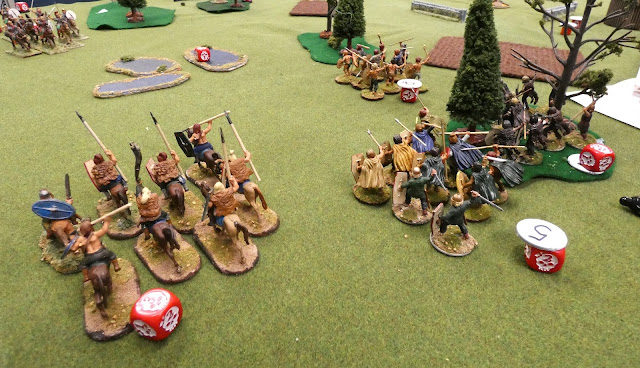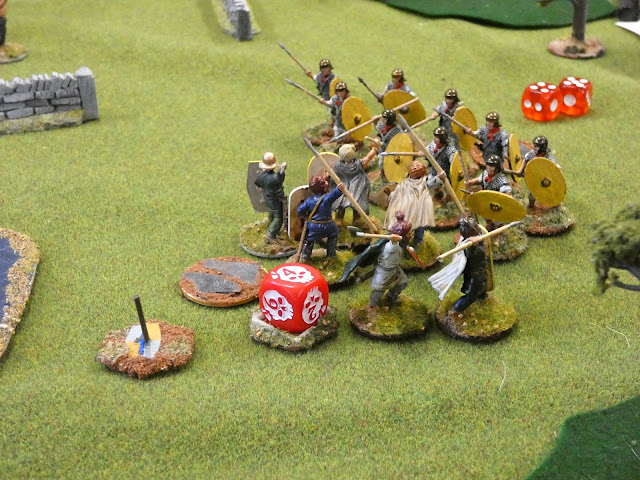I'm always interested in trying out unfamiliar rule systems, particularly with periods of personal interest and so I couldn't resist an invitation from Chas to join him in the forests of first-century Germania with a Roman punitive column and some rebellious German tribesmen getting stuck in using the rules Clash of Spears (CoS)
 |
| https://www.thewargamespot.com/clash-of-spears/ |
When it comes to playing ancients, I probably class myself as a 'big-battle' kind of wargamer, with the skirmish or even large skirmish gaming lower on my list of preferences, which is probably contrary to the current fashion in the hobby towards snappy, quick play, small scenario kind of games with rules to match.
The figure manufacturers seem to have cottoned on to this theme by producing small groups of figures to build retinues or warbands and I noted Victrix are involved in a similar exercise with this particular set.
For our game of 'Tree Huggers' versus 'Tree Choppers', as Chas decided to entitle our two sides, we had forces of just over 2,000 points, double the size of a recommended standard game of CoS at 900 points each, with our units ranging from seven to ten figures and the various unit definitions and stat lines taken from the Rise of Eagles lists pulled together by Chas using the handy Army Builder App to be found on the CoS Home Web Page, and in the link below.
 |
| CoS Army Builder |
The Romans mustering a force of some three units of legionaries, four of auxiliaries, one unit of archers and one of javelin men, two auxiliary cavalry and a Scorpio bolt thrower and crew.
The Germans were equally well represented with eight groups of warriors in various flavours, ranging from fanatics, veterans, Roman equipped to plain basic tribesmen, backed up with two units of javelin men, one of archers and a cavalry unit.
 |
| My command occupying the German left flank |
I don't intend to give a review of the rules here, but rather an impression of play using them, suffice to say each unit has the usual stat line of attributes for melee, ranged combat, morale, armour saves and any special abilities that would apply to a given unit, such as 'drilled' for Roman legionaries.
Stat numbers work on the basis that lower is better because you are dicing against them, hence 3+ is a success on 3 or more.
Movement is either in open or closed order, the latter offering better protection from close shields and range is taken from the nearest figures between two units.
 |
| The Roman Scorpio crew take aim |
The sequence of play is alternate, based on winning an initiative die roll, with the active player able to choose one of three options, do nothing and pass, activate a commander or unit or rest a unit to recover fatigue and with each side having the opportunity to activate any given unit up to three times, with the first activation guaranteed to happen before the enemy can react, but subsequent activations open to challenge by the opponent to try and get the jump on the second or third attempted move.
The actions of units usually consist of moving, throwing or shooting something and attacking in close combat.
 |
| Greg advances with his Auxiliary Cavalry |
The basic idea is, not surprisingly, to destroy the other chaps units whilst avoiding him doing it to you and this is achieved through an accumulation of fatigue points caused by casualties recieved and strenuous activities in close proximity to the enemy likely to lower morale, stamina and motivation.
Units can take up to six fatigue points with excess points causing casualties and more than double that number destroying the unit, and the little red dice seen next to units shows us recording said fatigue as we went, with some units gradually getting fewer in figures as fatigue caused casualties.
 |
| My Veterans and Fanatics, carrying a bit of fatigue as they move forward |
 |
| 'They shall not pass!' |
 |
| A strong force of Legionaries and Auxiliaries made up the Roman centre |
As with most large games in my experience, you only tend to have a superficial impression of what was happening on other parts of the battlefield, so most of my comments will be based on my part of it, but it appeared that the Roman centre got a bit of a hard time of it with the front two legionary units succumbing to missile fire followed by a bit of the close encounter, barbarian warband style, this after the German ranks were thinned with the odd Scorpion bolt and javelin.
 |
| Roman Auxiliary infantry out on the Roman left flank |
My cavalry of course went out on the extreme left and I brought up my veteran and fanatic warbands closely behind in the centre to support either or both the cavalry and spearmen ahead.
 |
| The view along the German line from their right flank, following deployment |
In the end my Germans beat the Roman auxiliary cavalry to the punch and managed to damage them heavily, with Greg deciding to swing his Barbarian Ally cavalry towards the Roman centre in support of his Javelin Men, which similarly got caught by my Spearmen Warband as they skirmished next to the Scorpion.
 |
| Close combat starting to accumulate the fatigue with four points on the German warband as they go toe-to-toe with Roman Auxiliaries |
As most of us playing were using CoS for the first time we were all keen to push the rules to the maximum to see what could happen, so missile fire and charges were flying in with 'gay abandon', and units started to melt in the heat of battle.
The game produces interesting decision points for players knowing when to push on after a successful round of melee for instance and perhaps push the opposition to breaking point with another round, or to hold back and look to recover incurred fatigue before pushing in again in the next round with the hope of winning the initiative to get that guaranteed first strike.
 |
| The Javelin Men add their missiles in support of the Scorpio bolts |
Thus the melee battles can be quite interesting little battles within the much wider contest and if carefully managed can enable an opponent to be rolled back in a grinding attack.
 |
| Roman Legionaries and Auxiliaries having a hard day in the centre |
We played about six hours and our game left both armies exhausted with numerous units removed from the table and both sides having relatively fresh ones ready to contest the sacred tree, so I guess we called it a bloody draw, without resorting to use the break off tests that are in the rules to decide when a force has reached that point through losses, and anyway it was 'Pub-Time' when we called it which pre-empts any break off tests.
 |
| My Spearmen about to charge out from the woods towards Roman Javelin men supporting the Roman Scorpion team |
My impression is the CoS is a solid work which draws on ideas I've seen in several other sets of rules and uses similar mechanisms, which is no bad thing, and indeed they produce a flowing game that easily handled the number of units on the table with six of us playing.
I think they are a set of rules that would reward regular playing to really get at the nuances of managing the game, knowing when to press forward and when to re-group, and we were all feeling our way to begin with, getting our heads around the various titles along the unit stat lines and which number to apply to any given situation, but not surprisingly that became more intuitive as we played.
 |
| My German cavalry charge towards their Roman counterparts as they try to manoeuvre around the marshes to their front. |
They are certainly pitched as a very competitive market, with the offerings around from Osprey and Footsore, but I think the fact that Victrix have aligned their range with them to supply specific units and with Roman, Carthaginian and Gallic box sets to build a complete force, I'm sure they will do well in an era of short games that can be played on a 6 x 4 foot table in two to three hours.
 |
| Victrix Clash of Spears Gallic Warband box set |
Thank you to Chas for organising and running our game, and to David, Steve M., Vince, Steve L. and Gregory for playing the game in our usual DWG spirit, good fun all round.
JJ




Nice report JJ. I think the rules have legs with players who have played them before. There are a lot of decision points & skill in how tou playbthw game.
ReplyDelete